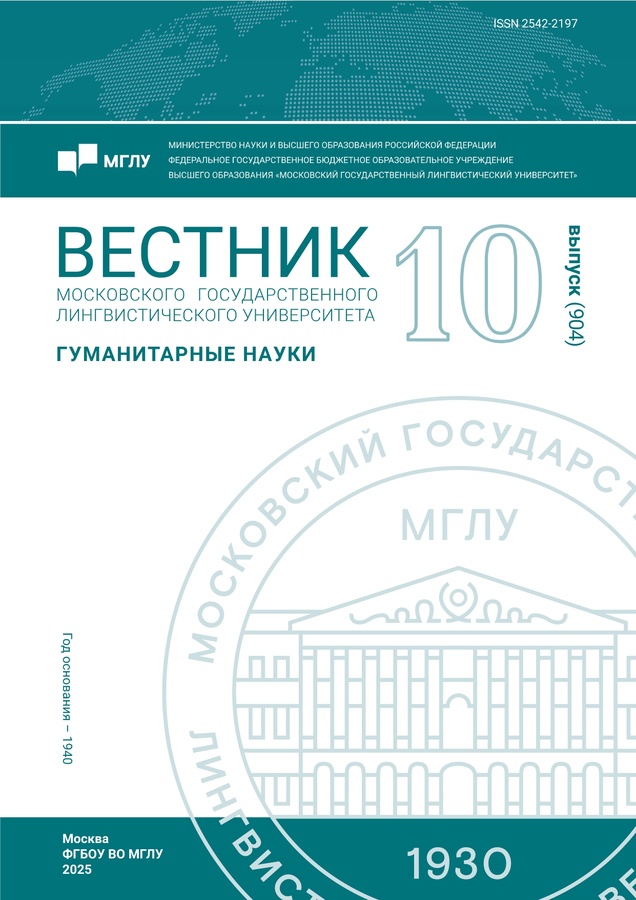Linguistic Features of the Documentary Genre in the Spanish Empire in the Second Half of the 18th Century
- Autores: Neshkes O.V.1, Raytarovskiy V.V.2
-
Afiliações:
- Moscow State Linguistic University
- Moscow International University
- Edição: Nº 10(904) (2025)
- Páginas: 72-79
- Seção: Linguistics
- URL: https://journal-vniispk.ru/2542-2197/article/view/352303
- ID: 352303
Citar
Texto integral
Resumo
The purpose of this study is to conduct a comprehensive linguistic analysis of two documents written the Spanish Empire related to the period of formation of the Neo-Hispanic language. The documents date back to the second half of the 18th century. The authors of the article show the historical significance of the analyzed documents, which record residual forms of baroque calligraphy, as well as cases of discrepancies between letters, phonemes and allophones expressed using alphabetic symbols. In addition, the article provides regional geographic comments. In the study the methods of comparative and contrastive, historical and genetic analysis are used. The results of the study can serve as additional material for determining the linguocultural features of the documentary genre of the Spanish language of this period, which is important for lexical and semantic transformation of such texts into Russian.
Palavras-chave
Sobre autores
Olga Neshkes
Moscow State Linguistic University
Autor responsável pela correspondência
Email: nesh_86@mail.ru
PhD in Philology, Associate Professor at the Department of Linguistics and Professional Communication in the Field of Political Sciences at the Institute of International Relations and Social and Political Sciences
RússiaViktor Raytarovskiy
Moscow International University
Email: v.raitarovskii@mmu.ru
PhD in Philology, Associate Professor at the Department of Romano-Germanic Philology and Oriental Studies, Institute of Foreign Languages
RússiaBibliografia
- Kochetova, L. A. (2015). Historical Discourse Studies in the Theory of Discourse. Vestnik of Moscow State Linguistic University, 6(717), 323−334. (In Russ.)
- Lázaro Carreter, F. (1974). Lengua Española, historia, teoría y práctica (vol. 2). Ediciones Anaya.
- Bosque, I., Demonte, V. (1999). Gramática descriptiva de la lengua española (vol. 1−3). Real Academia Española. Madrid.
- Menéndez Pidal, R. (1905). Manual elemental de gramática histórica española. V. Suárez.
- Vasil`eva-Shvede, O. K., Stepanov, G. V. (1963). Teoreticheskaya grammatika ispanskogo yazy`ka = Theoretical grammar of the Spanish language. Moscow. (In Russ.)
- Raevskaya, M. M. (2006). Ispanskoe yazykovoe soznanie Zolotogo veka (XVI−XVII vv.) = Spanish linguistic consciousness of the Golden Age (16th–17th centuries). Moscow: URSS: Lenand. (In Russ.)
- Zenenko, N. V. (2015). The Grammatical Space in the Context of the Hispanic Mindset. Moscow University Bulletin. Series 19: Linguistics and Intercultural Communication, 2, 134−142.
- Grigor’ev, V. P. (1983). Zhanrovo-stilisticheskaya opredelennost’ teksta i stanovlenie yazyka ispanskoy nacional’noy literatury = Genre and stylistic definition of the text and the formation of the language of Spanish national literature: Senior Doctorate in Philology. Leningrad. (In Russ.)
- Ortografia de la lengua castellana compuesta por la Real Academia española (1754). Segunda edición. Madrid: Real Academia Española.
- Sokolova, V. M. (2001). Istoriya stanovleniya i razvitiya ispanskoy orfografii = History of the formation and development of Spanish orthography: PhD thesis in Philology. Moscow. (In Russ.)
- Neshkes, O. V. (2023). Studying the specificity of the genre of diplomatic report in the second half of the 18th century. Vestnik of Moscow State Linguistic University. Humanities, 11(879), 50–56. (In Russ.)
- Petrov, A. Yu. (Ed.). (2020). Rossiya i Ispaniya na severozapade Ameriki vo vtoroy polovine XVIII veka (po materialam ispanskih arhivov) = Russia and Spain in the Northwest of America in the second half of the 18th Century (on materials from Spanish archives): monograph in documents. Compiler, under general editorship of A. Yu. Petrov; compiling editor V. N. Kostornichenko. Ryazan: Ryazan State University named after S. A. Yesenin Publishing house. (In Russ.)
- Litvak, N. V. (2018). Stanovlenie diplomaticheskoy sluzhby kak refleksivnogo instituta: obosnovanie koncepcii = Formation of the diplomatic service as a reflexive institution: substantiation of the concept: Senior Doctoral thesis in Social Sciences. Moscow. (In Russ.)
- Terentiy, L. M. (2006). Intencional’naya struktura diplomaticheskogo diskursa = Intentional structure of diplomatic discourse: Senior Doctoral thesis in Philology. Moscow. (In Russ.)
Arquivos suplementares










